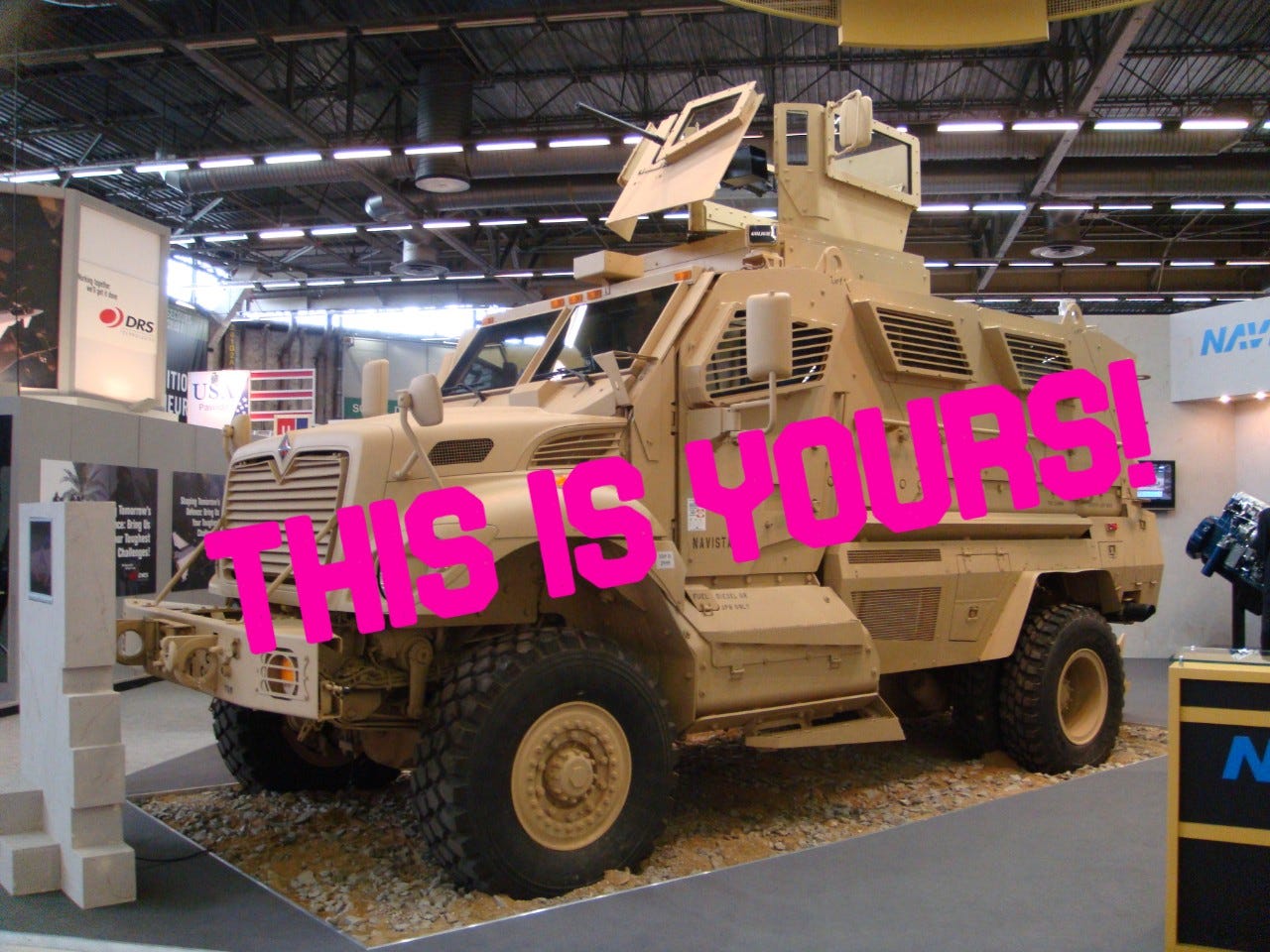Police grenade launchers: A civilian owner’s manual
A step-by-step guide to exposing the militarization of your local law enforcement agency

My friends were marching in a peaceful protest June 1 when a blockade of cop cars, humvees, and armored vehicles rumbled into view.
The point of the protest was to denounce police brutality and demand public oversight of police violence in the city of North Charleston, South Carolina. Ironically enough, the protesters’ list of demands included demilitarization of the police.
The deployment of military vehicles sent a clear message to protesters: The government sees you as combatants.
The police arrested seven people at the protest that day, enforcing an absurd 6 p.m. curfew in broad daylight after blocking some of the protesters from riding home with friends. It’s another version of the story that played out in cities across the United States these last few weeks as police kettled civilians with riot shields, blocked entrances to subways, gassed crowds with abortifacient chemical weapons, and escalated violence in outlandish shows of force.
I was struck by the image of one machine in particular that day, a hulking black MRAP (Mine-Resistant Ambush Protected) vehicle, apparently owned and operated by my city police department. I wondered why a 15-ton military transport designed to withstand IED blasts was rolling down the street to City Hall to police my unarmed neighbors.
With this week’s newsletter, I want to give you a quick manual for researching and pushing back against the militarization of your local law enforcement agency. The research portion is normally done by local journalists, but, as I’ve mentioned before in the newsletter, local journalism is dying and in some towns it is long dead. For better or worse, it’s up to us to demand answers.
Get the data
The primary way that military surplus tanks, grenade launchers, and automatic rifles end up in the hands of cops is through the Department of Defense 1033 Program, which provides military surplus equipment free of charge (local agencies only have to cover the cost of transportation and storage). This program started in 1997 under then-President Bill Clinton’s National Defense Authorization Act and has provided more than $5 billion worth of surplus military equipment to local agencies.
Fortunately for us, the Defense Logistics Agency’s Law Enforcement Support Office keeps a record of every property transfer under the 1033 Program. It’s in a gigantic spreadsheet and you’ll only have to do a little digging to find information about your community.
Don’t fear the spreadsheet! I’ll walk you through it:
Visit the LESO Public Information page by clicking here.
Under the heading LESO Property Transferred to Participating Agencies, select ALASKA - WYOMING AND US TERRITORIES. The spreadsheet will download to your computer.
Open the spreadsheet in your preferred program. If you don’t want to pay for Microsoft Excel, Google Sheets is a free alternative that works fine.
Find your state by scrolling through the tabs (in Sheets, these will appear along the bottom of the page).
By default, each state tab is organized alphabetically according to the Station Name (LEA) column. You can scroll until you find your local law enforcement agency, or you can set a filter. Click the funnel-shaped icon in the top menu to enable filters, then use the dropdown menu on a column header to select which values to show.
To get a good look at the flow of weapons into your state overall, clear the filters and right-click on the column labeled Item Name. Select Sort sheet A → Z. You can also set a filter in this column to only show certain pieces of equipment. For starters, look for item names like RIFLE,5.56 MILLIMETER; HMMWV (a.k.a. humvee), and MINE RESISTANT VEHICLE.

You’ll see lots of innocuous items like backpacks and medical equipment, but you might also find some things that surprise you.
For example, I learned that the North Charleston Police Department owns not one, but two MRAPs, with the most recent one arriving last year. The DoD has transferred 35 MRAPs to South Carolina law enforcement agencies since 2013, but only my local police department and the State Law Enforcement Division have the distinction of owning two. Lucky us!
I learned that South Carolina law enforcement agencies acquired a combined 2,823 5.56mm rifles and 156 7.62mm rifles from the U.S. military. Even tiny towns like Clinton and Bennettsville are now armed to the teeth and ready for, I dunno, Civil War 2.
I found some comic relief, too. I took a peek at Alabama’s tab and learned that the Gurley Police Department, serving a population of 801, acquired six sets of bayonets and scabbards in 2019. If I lived in Gurley, I would have some questions.

Get the context
The 1033 Program is one piece of the broader trend toward militarization of U.S. police. The influx of military weapons coincided with the rise of police training programs that emphasized the “warrior mindset” of soldiers in foreign theaters of war.
For decades now, police across the country have attended training sessions led by ex-military experts like David Grossman, whose popular “Killology” seminars teach them to (in Grossman’s own words) “kill without conscious thought.”
Here in South Carolina, the privately operated Government Training Institute in Barnwell trains SWAT teams and other police from across the country inside a former nuclear fuel reprocessing plant. When I went there to report on a deeply weird story in 2018, the company vice president told me this: “There was a big wall between law enforcement and the military. We helped crumble that wall.”


The last time we had a real national reckoning with police militarization was after the 2014 uprising in Ferguson, Missouri, following the police shooting of Michael Brown. Alarmed by photographs of camouflaged snipers training their weapons at crowds of protesters, news outlets began digging into the 1033 Program and discovered all sorts of combat gear in the hands of police departments across the country.
Police serving the Los Angeles Unified School District, famously, had acquired three grenade launchers and 61 assault rifles. The Marshall Project reported:
Police in Johnston, R.I., with a population less than 29,000, acquired two bomb disposal robots, 10 tactical trucks, 35 assault rifles, more than 100 infrared gun sights, and two pairs of footwear designed to protect against explosive mines. The Johnson police department has 67 sworn officers.
Under the glaring light of public scrutiny, President Barack Obama issued an executive order in May 2015 prohibiting the distribution of some types of equipment under the 1033 Program. Following through on a campaign promise to the Fraternal Order of Police, President Donald Trump rolled back that order in August 2017.
“The result?” wrote the American Civil Liberties Union in 2017. “Weapons of war will again be used to police our communities, no questions asked. Your town could be the next Ferguson or Fallujah.”
Get active
The ACLU has a petition going around demanding a moratorium on Act 1033. You should sign it! But I wouldn’t hold my breath for the Department of Defense to take action on it under a Trump presidency (or even, for that matter, a hypothetical Joe Biden presidency).
Apply pressure locally. Partner with local activist groups who are already in the fight, including local chapters of Black Lives Matter who have taken up the issue of police militarization. Seek out churches who take the “swords into plowshares” scripture seriously. If you have a local news outlet, encourage reporters to rake local police over the coals about this issue. Start by highlighting the most absurd acquisitions (high-caliber rifles, bayonets, and so forth) and go from there.
If you write letters to your elected officials, make them open letters. Start petitions and circulate them far and wide. Attend (or virtually attend) city council meetings and raise absolute hell. “Power,” Frederick Douglass said, “concedes nothing without a demand.”
We’re armed with the facts. Let's use them to disarm the police.


